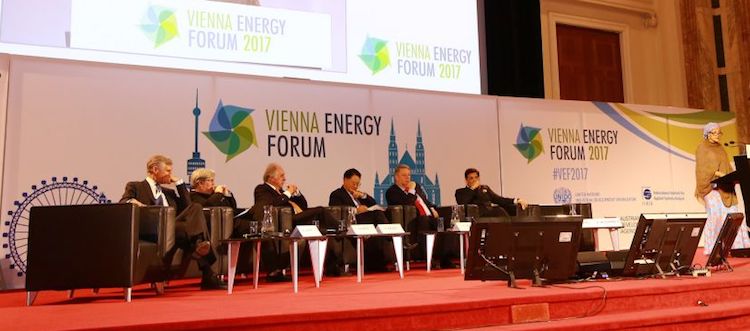Note: This report is based on a UNIDO media release issued on May 15. An independent analysis follows in the next few days. Meanwhile, we invite you to listen to our video interview with Piyush Goyal, India’s Minister of State with Independent Charge for Power, Coal, New and Renewable Energy and Mines. – The Editor.
VIENNA (IDN) – Clean and affordable energy for all will play a vital role in achieving the Sustainable Development Goals (SDGs) endorsed in 2015 and translating the 2016 Paris Climate Change Agreement into reality: this was the upshot of expert and high-level sessions of the four-day Vienna Energy Forum that concluded in the Austrian capital on May 12.
The fifth edition of the Forum co-organized by the United Nations Industrial Development Organization (UNIDO), the International Institute of Applied Systems Analysis (IIASA), the Austrian Government, and Sustainable Energy for All (SEforALL) brought together more than 1,650 participants from 128 countries.
An outcome document of the Forum is “expected to be issued in several weeks,” according to UNIDO, which has however determined 10 key messages emerging from discussions:
The role of energy in the 2030 Global Development Agenda:
Much of the capital investments we make today have a very long replacement time, therefore the energy choices we make today will lock us into a development path for decades to come. Long term integrated strategies are imperative to cover all SDGs. The deadline set for the SDGs highlights the urgency of advancing forward now if we are to achieve these goals by 2030, show substantial progress by 2020 and gather momentum for the future 2050 development targets. The vision for 2050 for sustainable development must shape the decisions made today.
The energy, food security, land, water, and health nexus:
Energy is the key enabler for food security, health, land and water. From food refrigeration to wastewater treatment, energy is a basic requirement for rapid and healthy development. The urgency of the implementation phase of the SDGs and the Paris Agreement highlights the need for a holistic approach which mitigates the trade-offs while positively enhancing the numerous interlinkages between these sectors.
Sustainable cities and communities:
With the global megatrend of rapid urbanization, its proportionally growing energy demand and corresponding greenhouse gas emissions, cities are calling for innovative approaches to urban design and transformative change. One of the solutions could be innovative infrastructure that uses renewable energy in an efficient way to cope with the rising demand of energy without detrimental impact on the climate and the environment.
SDG 7- Affordable and clean energy and SDG 13 – Climate action:
Affordable and clean energy is the biggest opportunity to mitigate climate change, and a measure of adaptation. The majority of the Nationally Determined Contributions see the energy sector as a vital component to achieve the objectives of the Paris Agreement. Technology transfer, investment, capacity building and institutions will help energy play its role in fighting climate change.
The pioneering role of innovative technologies:
Technological innovations are central for sustainable energy development. New concepts and game-changing technologies are being introduced but the level of readiness is still uncertain. This is the first generation that has the technology to solve climate change and related problems of sustainability. Current development strategies need to be continuously updated to reflect the new available technological innovation.
Financing innovative business models:
Sustainable solutions depend on innovative and inclusive business models that can be scaled up, replicated, and are self-sustaining. These business models exist already and are ripe for financing by financial institutions, development banks, as well as private investors. The financial resources necessary to accomplish SDG 7 and the Paris Agreement also exist, yet the appropriate instruments are not being applied in a way that enables new businesses to blossom and large-scale projects to move forward. This represents a collective opportunity for collaboration and partnerships between the public and private sector to provide such solutions.
Catalysts for innovation:
Governments are able to stimulate innovation by demonstrating political commitment and setting ambitious targets and plans to provide the incentives to realize those goals; supporting research and development in cross-sectoral innovation and providing platforms to deliver technologies and integrated solutions that respond to differentiated needs of the users; and by developing the energy system based on an integrated network rather than a top down approach.
Innovation for appropriate and sustainable solutions:
Recognizing that innovation works at multiple levels, and that it can trigger fast and transformative change, target-setting and regional cooperation can further ensure that results of innovation trickle down through all levels. Additionally, women are the best placed agents to absorb innovation and successfully turn it into higher income and better lives. Private sector players can also help drive down the cost and increase the efficiency and speed of mainstreaming of innovation.
Energy crucial for security:
Energy can contribute to the security needs of various countries. The elements of trust, confidence and transparency are essential enablers for the means of implementation. Additionally, tailored sustainable solutions for specific national needs are vital in ensuring the success in meeting global sustainable development agreements.
Role of private sector in advancing sustainable development:
The role of the private sector in implementing the SDGs and the Paris Agreement is growing, and the public sector should embrace it as one of the drivers of innovation. The design of policy should incorporate the needs of small and medium enterprises in developing countries. This can be done alongside the creation of frameworks which enable new entrepreneurs to create quality and cost effective solutions which can address energy and sustainability demands simultaneously. [IDN-InDepthNews – 16 May 2017]
Photo credit: UNIDO


